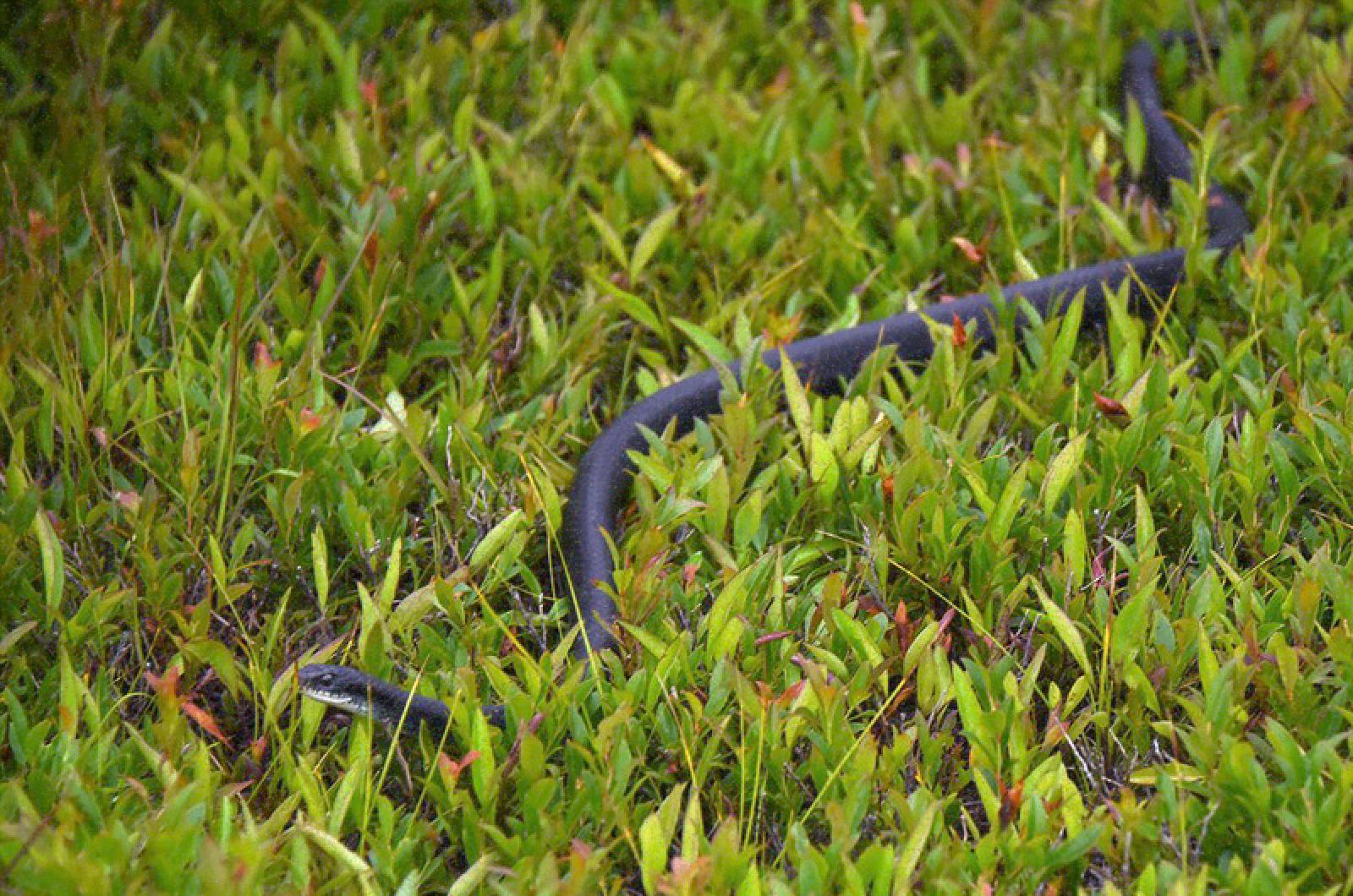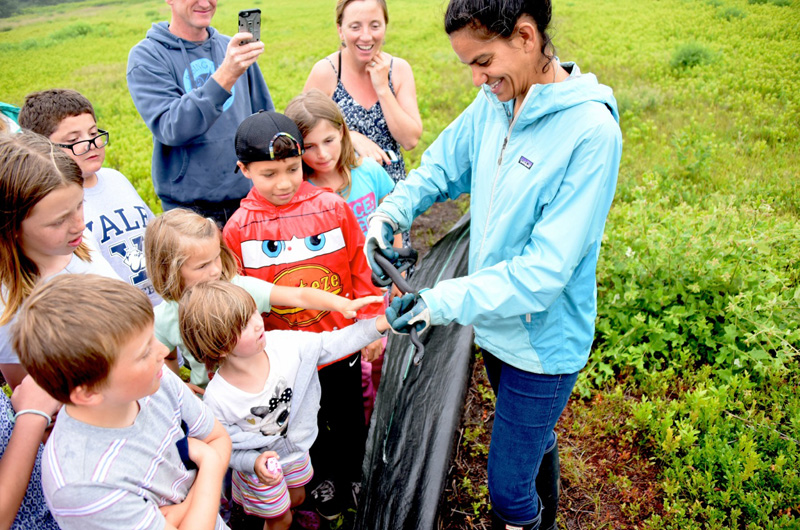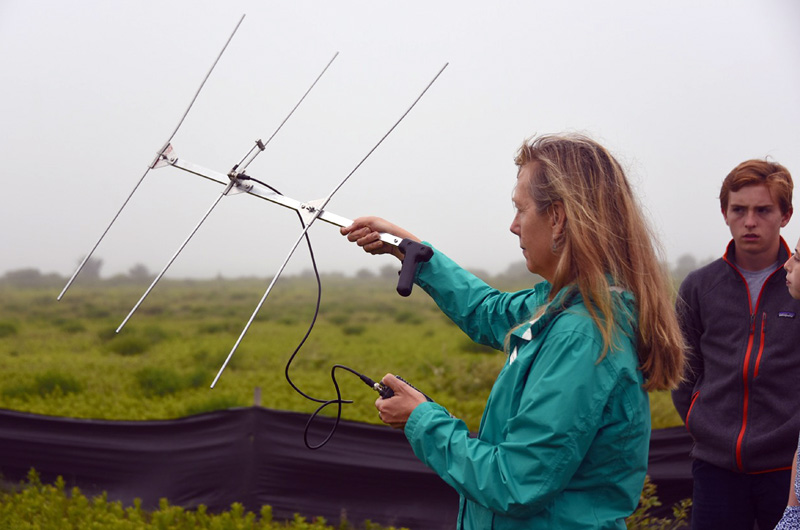Just east of the Katama Airfield last week, a group of kids made their way across the sandplain grassland to a spot where black silt fencing formed an X with a plywood box in the middle. The sound of crashing waves in the distance made its way over the foggy landscape that is home to a black racer snake named Katama.
Annie Adams, a young volunteer for BiodiversityWorks in Vineyard Haven, discovered the snake in the plywood box on Thursday evening. It was only the second adult black racer that BiodiversityWorks has captured since it began studying the species in 2014. The silt fencing directs snakes toward the box, where orange highway cones let them in but not out. Annie named the snake after its south-shore habitat.
“I was not expecting anything to be in there,” she said Friday, when she and others gathered in the grassland for Katama’s release. “We were already late for a dinner, so I was like, okay, we’ll just get this done. And I looked in there and there was a snake.”
As with the previous capture (a slightly older female named Miss Audrey, after volunteer Audrey van der Krogt who found her at the Long Point Wildlife Refuge in Edgartown last summer), Katama’s behavior over the course of a year will help BiodiversityWorks better manage the species, which has declined greatly in the last 20 years — largely as a result of habitat fragmentation and increased traffic.
About a dozen kids joined researchers for Katama’s release on Friday, including some from Camp Awesome, which had taken part in the Long Point study. Kendra Buresch, director of kids’ programs for BiodiversityWorks, along with seasonal workers Nicole Lynch and Anita Michalak were also on hand for the event.
Black racers (Coluber constrictor) have been documented on the Vineyard as far back as the early 1800s, but little is known about the Island population. By tracking snakes like Audrey and Katama, BiodiversityWorks hopes to collect enough baseline data to inform management techniques across the Island.
Veterinarian Michelle Jasny sedated Katama last week and surgically implanted a small transmitter in her side. It was the same process for Audrey, whose yearlong tenure is now coming to an end. BiodiversityWorks plans to recapture Audrey in the near future, remove the transmitter and release her back into the wild.
Katama now takes her place, but in a much different habitat than the wooded expanse at Long Point where Audrey has spent the last year.
On the foggy grassland last week, BiodiversityWorks assistant director Liz Baldwin reached into a pink pillowcase and retrieved Katama, who nervously vibrated her tail and tasted the air as kids took turns touching her charcoal gray scales.
“We are really interested to see what this snake does, because we are catching her right on the edge of a housing development,” BiodiversityWorks director Luanne Johnson said, noting some houses at the edge of the field. She also noted the nearby airfield, and smaller dirt roads in the area.
With a lack of trees, Katama might be easier to track than Audrey, who was known to hide inside tree cavities. “But then the question will be where does she spend the winter,” Ms. Johnson said. Audrey spent last winter in chipmunk burrows, she said, but researchers never found her hibernating with other snakes, which was something of a surprise.
BiodiversityWorks has another trap on land owned by the Sheriff’s Meadow Foundation near Stonewall Beach in Chilmark. Ms. Baldwin said if a black racer is captured there (a smaller field than the one in Katama) it will also be tagged and tracked.
“We are really interested to see how the snakes are going to move in these different habitats,” Ms. Baldwin said, adding that with enough data, researchers could project the species’ behavior throughout its Island habitat, which appears to be limited to the south shore between Edgartown and Aquinnah.
Audrey seemed relatively content in her woodland habitat, where she remained all of last year and rarely crossed any roads. She was observed mating this spring, and has lately been visiting the sandy banks of a pond, which indicates she was laying her eggs. Ms. Johnson said black racers can live up to 15 years, which could give Audrey many more years to wander her woodland habitat. Based on her smaller size, Ms. Johnson estimated that Katama is less than three years old.
After walking a little ways beyond the trap on Friday, Ms. Baldwin gently placed Katama on the ground. People bid farewell as Katama slithered away through the grass, hesitating now and then and tasting the air before disappearing into the landscape.
“See you later, Katama,” Ms. Buresch said.









Comments (2)
Comments
Comment policy »